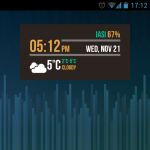Unofficial CyanogenMod 10.1 available for the international Samsung Galaxy S III

Just over a week ago, Steve Kondik, the founder of the popular custom distribution CyanogenMod, revealed that CM10.1 builds based on Android 4.2 Jelly Bean will soon be released for US variants of the Samsung Galaxy S III. However, the highly anticipated custom ROM is already available for the international model, albeit with unofficial tags.
Galaxy S III users that want to install the unofficial builds can expect a similar functionality to the official CM10.1 releases available today. As the feature porting process is not completed, it won’t come as any surprise that some of the features included in previous CyanogenMod iterations are still missing or not yet adapted for Android 4.2 Jelly Bean. Due to the unofficial nature and the infancy of the source code, users may also encounter some bugs as well.
The unofficial CyanogenMod 10.1 release can be installed just like any other by flashing the available build and the adjacent Google Apps package using a compatible custom recovery tool such as ClockworkMod or TWRP.
Oppo announces Find 5 with quad-core processor and 1080p display

If you haven't heard of Oppo before, I don't blame you. Awareness of the company's existence in mature Western mobile markets is practically nonexistent. However, that hasn’t stopped the Chinese manufacturer from announcing the Find 5, a surprising smartphone coming to the US market shortly.
Oppo's handset features specs that rival those of HTC's Butterfly (or DROID DNA as it is known in the United States), which is rather impressive. The Find 5 sports a 5-inch display with a resolution of 1920 by 1080 and a 441 ppi density. Power comes from a quad-core 1.5GHz Qualcomm Snapdragon S4 Pro (codename "APQ8064") processor backed by 2GB of RAM and an Adreno 320 graphics card. The smartphone's 2500mAh battery though is larger than the one found in the Butterfly/DROID DNA, which comes in at only 2020mAh.
Samsung Galaxy Note II receives Android 4.1.2

Little more than three months ago, Samsung introduced the Galaxy Note II, running Android 4.1.1 Jelly Bean. Shortly afterwards Google issued a minor update to its OS, Android 4.1.2, and starting today you can get it for Samsung’s popular green droid device.
On Nexus-branded hardware, Android 4.1.2 only delivered minor changes. For the Galaxy Note II, however, Samsung has apparently introduced more significant benefits. The most noteworthy features include a higher number of notification toggles, swipe gestures using the built-in keyboard, a new lockscreen effect and a customizable notification panel.
Google Now powers up with new features: dictate G+ posts, song ID, boarding passes, more

Google first introduced its Siri-like voice search Google Now in Android 4.1 (Jelly Bean). Functionality was rather limited at first, but the search giant eventually added new "cards" (data feeds on user-selected topics) and even Gmail integration. With the latest iteration released today, users can do a lot more with Google Now, including dictate Google+ posts and show United Airlines boarding passes.
Users can power up Google Now, tap on the microphone icon, say "Post to Google Plus" and then simply add their message. Automatic posting is not enabled, so users can edit and select the circles which will see the message. Another new feature is the ability to scan barcodes, which is triggered by the fairly intuitive command "Scan a barcode". Using the camera, Google Now allows users to take a picture of the item in order to display relevant product information.
CyanogenMod 10.1 nightly builds available for Google Nexus 10, soon for US Samsung Galaxy S IIIs

Almost a week ago the team behind the popular custom Android distribution CyanogenMod announced that Android 4.2-based nightly builds for the Google Nexus 10 were on the way. The developers kept their word and have now delivered the first official CyanogenMod 10.1 release for the 10-inch tablet.
The CM10.1 builds for the Nexus 10 (codename "Manta") are available with December 3 and December 4 time-stamps. Users should expect a number of features to be missing due to the early nature of the development and on-going feature porting process. However, Quiet Hours, the battery percentage indicator, and Trebuchet launcher are all included. Steve Kondik, the project's founder, has further good news for CyanogenMod fans.
A third of Android devices now run Ice Cream Sandwich and Jelly Bean

Jelly Bean may be the youngest member of the Android family, but it’s also enjoying some amazing month-on-month growth, based on the number of devices accessing Google Play during the 14 days ending December 3. It still has some way to go to match Gingerbread though, which is yet again the green droid ruler.
On November 13, the search giant introduced its latest sugary treat, Android 4.2. Three weeks later, the new version of Jelly Bean had claimed a distribution level of 0.8 percent, a number aided by Nexus 4 and Nexus 10 sales, and Galaxy Nexus and Nexus 7 upgrades. That growth however, pales in comparison to 4.1 Jelly Bean which is now found on 5.9 percent of green droid devices, an increase of 118 percent when compared to the previous figures released in early November.
Finally! Motorola Droid Razr HD and Maxx to get Android 4.1 Jelly Bean

When Motorola introduced the Droid Razr HD and Droid Razr Maxx HD for Verizon Wireless there was one major feature missing from the spec sheet -- Android 4.1 Jelly Bean. Three months later, the big red finally announced that the two smartphones will be upgraded to the first Jelly Bean iteration starting this week.
The software update for the Droid Razr HD and Droid Razr Maxx HD comes in at a fairly significant 276MB in size and it bears the "9.1.41.XT926.Verizon.en.US" moniker. Users should expect a customized Android 4.1 Jelly Bean experience with the typical Motorola add-ons and Verizon-branded apps. Some of the most significant changes introduced by the upgrade include better voice search capability through Google Now, expandable notifications, revised keyboard and an overall improved responsiveness due to Project Butter.
Google posts Android 4.2.1 factory images for the Nexus 4, 7, 10 and HSPA+ Galaxy smartphone

Just three days ago Google released the Android 4.2.1 Jelly Bean update which now recognizes that December and Santa Claus do exist. Today the Mountain View, Calif.-based corporation updated the factory images for the Nexus 4, 7, 10 and HSPA+ Galaxy Nexus with the latest version of the green droid operating system.
Using the factory images the four Nexus devices can be directly upgraded to Android 4.2.1 Jelly Bean, build number JOP40D, without waiting to receive the over-the-air update. In similar fashion, green droid modders can take advantage of the factory images to restore the devices to stock after previously using a custom distribution such as AOKP Jelly Bean Milestone 1 or CyanogenMod 10.
Google Nexus 4 and 10 get official CyanogenMod 10.1 nightly build

If you're one of the lucky few Google Nexus 4 or Nexus 10 owners around the world that prefer a third-party ROM to Android 4.2 Jelly Bean, then you're in luck. Today the team behind the popular CyanogenMod custom distribution released an official CM10.1 build for the LG-made smartphone, with another on the way for its tablet sibling.
The CyanogenMod 10.1 build for the Nexus 4 comes in response to unofficial custom distributions, that recently surfaced, built using the former's source code. The first release available to the general public is based on Android 4.2 Jelly Bean, rather than the newest version issued yesterday. However a missing December in the People app is unlikely to hinder its success considering CyanogenMod's popularity among the modding community.
Google Nexus 4 first-impressions review

The LG-manufactured Nexus 4 is nearly perfect. Unless you have no other choice, perhaps because of unsupported cellular carrier and binding contractual commitment, put Google's newest smartphone at the top of your must-buy list. The device satisfies in all the right places -- battery life, call quality, display clarity, size and visibility, operating system and performance. There are other Androids with comparable or better hardware, but they typically slap on a secondary UI and ship with older OS. It's not the measure of one attribute, or even a couple, but many combined that make Nexus 4 so good.
But nearly isn't perfect. Nexus 4's flaws, while subtle, will be serious for some potential buyers. There is no 4G LTE, for example. The feature is built-in to the Snapdragon processor but not properly enabled. The phone is HSPA+ for data, which works on GSM carriers like AT&T and T-Mobile USA. No LTE is a deal-breaker for some people, as seen in commments here and elsewhere. Something else: LG copied Apple, which put glass on the back of iPhone 4 and 4S and rightly abandoned the design with the newest handset. Double-sided glass makes the phone less durable than should be, particularly if dropped. Finally, many Galaxy Nexus users won't find its successor to be a compelling upgrade; much depends on what they use their phones for.
Google recognizes that December exists in Android 4.2.1 update

Two weeks ago, Google launched Android 4.2 Jelly Bean, the latest treat in the candy jar. In addition to delivering a number of improvements, the new operating system also introduced some software issues. As a response to this, the Mountain View, Calif.-based corporation started rolling out the Android 4.2.1 update for the Nexus 4 and Nexus 10 on Tuesday.
The most notable mishap in Android 4.2 is the missing month of December in the People app. This bug caused quite a controversy around the interwebs, with plenty of sarcasm and humor directed towards Mountain View for dismissing Christmas.
Unofficial AOKP and CyanogenMod Android 4.2-based builds surface

Modding fans, you're in luck. Shortly after Google released Android 4.2 Jelly Bean and pushed it to AOSP, custom ROM developers started work on new builds. The effort has paid off, as new unofficial AOKP and CyanogenMod releases are available, based on the latest version of the green droid operating system.
Almost two weeks ago the CyanogenMod team announced that a future version based on Android 4.2 Jelly Bean would be released, but without mentioning a launch date. In the meantime, sporting minor alternations, custom distribution JellyBro is available using the CM 10.1 source code. The currently available build contains a limited number of enhancements, due to early stages of the feature porting process. However, if Android Open Kang Project is preferred, then developer Roman Birg has some good news.
Notification Weather available at a swipe

The notification toolbar is commonly altered by manufacturers to include toggles, but what about a more down-to-Earth feature? Android is known for its customization prowess, and weather information can be delivered by a simple swipe using Notification Weather.
Instead of going over the top, the app takes a conservative approach by employing a look and feel that could even pass as stock functionality. It bears an uncanny resemblance to CyanogenMod 10's lockscreen implementation. For the present day Notification Weather displays the location, status ("cloudy" for instance), characteristic pictograph (cloud, drops, etc.), current temperature with minimum and maximum values of the day as well as wind temperature.
Beautiful Clock Widgets: Get more time from Jelly Bean lockscreen

Android 4.2 introduced the ability to add widgets on the lockscreen, allowing users to view more information without unlocking the device. Beautiful Clock Widgets is an app designed to take advantage of the new feature by offering a large selection of time & weather widgets.
Beautiful Clock Widgets can display more comprehensive information than the default Clock widget that Google offers. Users have access to the typical time (in AM/PM format) and date, but also to humidity percentage for the selected location as well as current temperature with minimum and maximum values of the day and a short status like "Cloudy". For every feature a different color can be assigned (for instance red for location, green for weather, purple for background, etc.).
HTC DROID DNA available for purchase at Verizon Wireless

Starting today the HTC DROID DNA is available for purchase at Verizon Wireless. On a two-year contract the J butterfly's US brother runs for $199.99, while off-contract it costs a marginally higher $599.99.
Like the J butterfly, the DROID DNA comes with a massive 5-inch Super LCD3 display with 1920-by-1080 resolution and Corning Gorilla Glass 2 for protection. Power comes from a 1.5GHz quad-core Qualcomm Snapdragon S4 Pro processor backed by 2GB of RAM and a relatively small 2020mAh non-removable battery. Unlike the J Butterfly, the big red version has to make due with just 16GB of internal storage as it does not feature a microSD card slot.
Recent Headlines
BetaNews, your source for breaking tech news, reviews, and in-depth reporting since 1998.
© 1998-2025 BetaNews, Inc. All Rights Reserved. About Us - Privacy Policy - Cookie Policy - Sitemap.